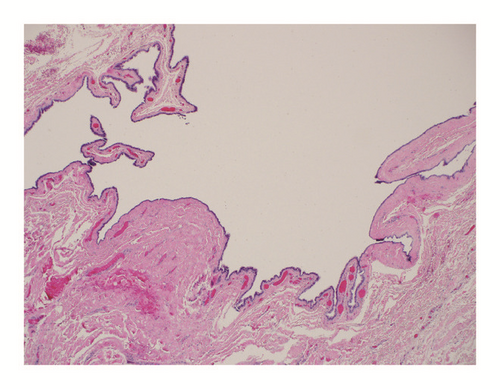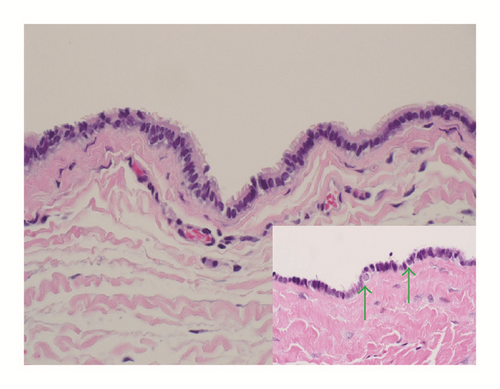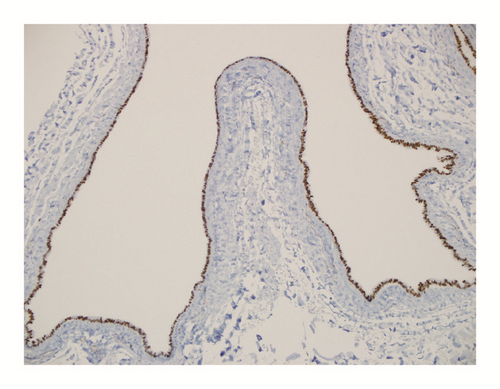Mullerian-Type Ciliated Cyst of the Thigh with PAX-8 and WT1 Positivity: A Case Report and Review of the Literature
Abstract
Mullerian-type ciliated cysts are uncommon lesions usually found in the lower extremities and perineal region of young females. They have however been reported in males and in other anatomic sites. The cyst lining is typically positive for estrogen receptor (ER), progesterone receptor (PR), PAX-8, and WT1 immunohistochemical stains. This staining pattern has led to the notion that these cysts are of Müllerian origin. The vast majority of cases are located in the dermis where the preferred nomenclature is cutaneous ciliated cyst (CCC). We report a case of Müllerian-type ciliated cyst in the thigh of a 16-year-old girl. Unlike most of the cases reported in the English literature, this cyst was not centered in the dermis. Only a few other cases of Müllerian-type ciliated cysts with no cutaneous connection have been reported. We propose the term ectopic Müllerian cyst for this rare subset of lesions that are not skin based as is the current case.
1. Introduction
Cutaneous ciliated cysts (CCC) also known as cutaneous Mullerian cysts are rare lesions which mostly occur in the lower extremities of females [1]. Up to 2015, 60 cases of CCC had been published, of which 50 were in female patients and 10 in males. These cysts are believed to arise from ectopic Mullerian rests which become active during puberty or pregnancy [2]. We present a case of a CCC without obvious cutaneous connection occurring in the thigh of a 16-year-old girl [3]. By immunohistochemistry, estrogen receptor (ER), progesterone receptor (PR), PAX-8, and WT1 were positive in the epithelial lining of the cyst, lending support to a possible Müllerian origin [4].
2. Case Report
A 16-year-old girl presented with a solitary, 2 cm, freely mobile mass in the soft tissue of the right thigh. The cyst had been present for at least 3 years. According to the patient, the mass has waxed and waned but was for the most part increasing in size. There is no associated rubor, calor, pain, tenderness, skin changes, or drainage. She denied fever, anorexia, asthenia, and weight loss. She has no significant past medical or surgical history. There is no history of pregnancy or preceding trauma. At surgery, the mass was situated in the subcutaneous soft tissue. It was incised revealing its cystic nature. The cystic fluid was expressed and the mass was completely excised and sent to the pathology department for further evaluation.
Surgical pathology received a 2.5 cm tan-brown collapsed unilocular cyst. Skin was not identified in the specimen on gross inspection. The cyst wall measured 0.1 cm in thickness. The inner lining was tan, smooth, and glistening. Representative sections were submitted for microscopic examination. On low magnification, sections showed a cystic lesion whose fibrocollagenous wall was thrown into multiple folds forming finger-like projections focally (Figure 1). A thorough search for skin appendages such as hair follicles, sebaceous glands, and sweat glands revealed no such structures. High magnification revealed a cyst lining formed by a simple ciliated cuboidal to columnar epithelium with no significant cytologic atypia (Figure 2). Pseudostratification was evidenced focally. Occasional cells with round nuclei and perinuclear clearing seen towards the base of the epithelium were reminiscent of cells seen in fallopian tube epithelium (Figure 2, inset). In the fallopian tubes these cells are thought to be intraepithelial lymphocytes. No smooth muscle, cartilage, mucus glands, or adnexa were identified in the cyst wall. There was no significant inflammation. By immunohistochemistry, the epithelial cells were positive for pan-cytokeratin (AE1/AE3), estrogen receptor (ER), progesterone receptor (PR), PAX-8, and WT1 (Figures 3(a), 3(b), and 3(c)). The latter 4 are markers of Mullerian origin.





3. Discussion
Cutaneous ciliated cyst is an uncommon lesion with only 60 cases reported in the English literature between 1890 and 2015 (Table 1). The entity was first described by Hess in the seminal paper in 1890 [5]. The term cutaneous ciliated cyst was eventually coined by Farmer and Helwig in 1978 to describe a unique type of cyst arising in the lower extremities of young women. They reported lesions occurring in 11 patients, all of whom were female, with an age range from 15 to 30 years. The average age was 22. In their theory, they proposed that heterotopic Mullerian tissue is sequestered during embryonic development. This results in hormone responsive Mullerian rests being deposited at specific sites leading to the formation of Mullerian-type cysts after puberty when there is an increase in hormone production. These cysts may show a growth phase during pregnancy when hormonal activity is once again elevated [1, 4, 6]. The origin still remains controversial today with various theories being proposed. These theories range from the previously mentioned Mullerian heterotopia to metaplasia of sweat gland (eccrine) epithelium to embryonic remnants of the cloacal membrane [5, 6].
| Number | Year | Sex | Age | Location | Duration | Authors |
|---|---|---|---|---|---|---|
| 1 | 1890 | Female | 15 | Back | Recent | Hess |
| 2 | 1969 | Female | 39 | Left leg | >10 years | Clark |
| 3–6 | 1970 | Female | 15–27 | Thigh × 2 | 2 to several years | Butterworth et al. |
| Female | Right buttock | |||||
| Female | Knee | |||||
| 7–17 | 1978 | Female | 15–30 | Buttock | Weeks to 5 years | Farmer, Helwig |
| Female | Thigh × 4 | |||||
| Female | Calf × 4 | |||||
| Female | Foot × 2 | |||||
| 18 | 1980 | Female | 33 | Right sole | 2 months | True, Golitz |
| 19 | 1982 | Female | 15 | Thigh | 7 months | Park et al. |
| 20 | 1982 | Male | 42 | Heel | 5 years | Leonforte et al. |
| 21 | 1983 | Female | 36 | Left foot | Early teens | Ross, Schwartz |
| 22 | 1990 | Female | 42 | Right buttock | Long standing | Al-Nafussi, Carder |
| 23 | 1990 | Female | 18 | Left buttock | 4 years | Varma et al. |
| 24 | 1993 | Female | 22 | Scapula | Long standing | Sabourin et al. |
| 25 | 1994 | Female | 20 | Scalp | 3 years | Sickel et al. |
| 26 | 1994 | Male | 28 | Left foot | Not stated | Trotter et al. |
| 27 | 1995 | Female | 16 | Left buttock | Recent | Biernat, Biernat |
| 28 | 1995 | Female | 14 | Right thigh | 10 months | Cortes-Franco et al. |
| 29 | 1995 | Female | 19 | Right buttock | 2 years | Tachibana et al. |
| 30 | 1995 | Female | 17 | Right sole | 2 years | Osada et al. |
| 31 | 1995 | Male | 27 | Right sole | 2 years | Ashton |
| 32 | 1997 | Male | 60 | Perineal area | 2 years | Sidoni et al. |
| 33 | 1997 | Female | 11 | Left foot | 1 year | Innocenzia et al. |
| 34 | 1999 | Female | 23 | Right lower leg | 1 year | Yokozaki et al. |
| 35 | 2000 | Female | 12 | Sacrococcygeal | Months | Dini et al. |
| 36 | 2001 | Female | 13 | Sacrococcygeal | 1 year | Lee et al. |
| 37 | 2002 | Female | 14 | Lower abdomen | 3 months | Fontaine et al. |
| 38 | 2002 | Male | 53 | Right cheek | 2 years | Ohba et al. |
| 39 | 2002 | Female | 18 | Abdomen | 6-7 months | Vadmal et al. |
| 40 | 2004 | Male | 54 | Perineum | New discovery | Santos et al. |
| 41 | 2006 | Male | 56 | Right inguinal area | 3 years | Lee et al. |
| 42 | 2006 | Female | 41 | Umbilicus | 3 months | Kim et al. |
| 43 | 2007 | Female | 16 | Left thigh | 1 year | Chong et al. |
| 44 | 2008 | Female | 54 | Paravertebral | 8 years | Businger et al. |
| 45 | 2008 | Male | 15 | Scrotal area | Recent | Pérez Valcárcel et al. |
| 46 | 2009 | Female | 51 | Left leg | 2 years | Torisu-Itakura |
| 47 | 2010 | Female | 13 | Right leg | 2 years | Bivin et al. |
| 48 | 2011 | Female | 25 | Not stated | 2 years | Gelincik |
| 49 | 2011 | Female | 48 | Right heel | Several years | Stevens, Sarma |
| 50 | 2011 | Female | 14 | Right knee | 4 years | Ashturkar et al. |
| 51 | 2012 | Female | 16 | Left thumb | Not stated | Hung et al. |
| 52 | 2013 | Female | 15 | Right hip | 1 year | Rodrigo-Nicolás et al. |
| 53 | 2014 | Female | 20 | Left knee | 10 years | Joehlin-Price et al. |
| 54 | 2014 | Female | 22 | Pretibial | 2-3 years | Joehlin-Price et al. |
| 55 | 2014 | Female | 13 | Gluteal cleft | 1 month | Oh et al. |
| 56 | 2014 | Female | 53 | Scalp | Lifelong | Reserva et al. |
| 57 | 2014 | Female | 38 | Popliteal fossa | 1 year | Kavishwar et al. |
| 58 | 2015 | Male | 14 | Scrotum | Not stated | Swarbrick et al. |
| 59 | 2015 | Male | 7 | Left posterior neck | 3 years | Kim, Kim |
| 60 | 2015 | Female | 14 | Right lower leg | 1 year | Keisling et al. |
Mullerian cysts may present as solitary unilocular or multilocular lesions. The ciliated epithelial lining is reminiscent fallopian tube epithelium [5]; however squamous metaplasia may be present focally [1]. There is generally no cytologic atypia or increased mitotic activity. The majority of cysts being located in the lower limbs may be explained by the close proximity of the Mullerian ducts to the lower limbs during development. However, the presence of similar cysts at distant sites such as scalp and mediastinum may be explained by vascular or lymphatic dissemination [7].
Despite the various theories proposed with respect to their origin, the Mullerian heterotopia theory is supported by this striking resemblance to fallopian tube epithelium and by the consistent nuclear positivity for antibodies to the steroid receptors for estrogen and progesterone [6]. PAX-8, a member of the paired box (PAX) family of transcription factors which is important in the development of Mullerian and thyroid organs, has been shown to be expressed in the nuclei of the lining cells of these ciliated cysts by immunohistochemistry in recent publications [4]. This finding further supports the possibility of a Mullerian origin as PAX-8 immunohistochemical stain is currently used to identify Mullerian tumors among others. Immunostain for WT1, the product of a gene which is essential for the development of the kidneys and gonads, is also positive lending further support to a Mullerian origin of these cysts. As a matter of fact the staining pattern of the epithelium for dynein is reported to be similar to that of fallopian tubal epithelium [8].
Of note however, similar cysts have been reported in male patients [6, 9, 10] and interestingly, at least 2 of these cases were from the scrotum [11, 12]. The presence of cysts with similar histomorphology in male patients has led some authors to gravitate towards the sweat gland origin theory as estrogen stimulation is thought to influence the development of Mullerian derived cysts. Leonforte described the first case of ciliated cyst in a male patient in 1982 and even then he noted histologic similarities to sweat glands. In his case he described the presence of PAS-positive granules and apical caps in the epithelial cells, both features of apocrine sweat glands. The presence of dilated eccrine ducts in the vicinity of the cyst and the fact that eccrine glands are normally present in the heel, the site of the cyst in his report, and a site devoid of apocrine glands led him to suggest a possible eccrine origin. The changes in the epithelium to resemble that of fallopian tube were attributed to a metaplastic process caused by inflammation and subsequent irritation of pluripotent cells triggered by the cyst’s contents [13].
In 1997 Sidoni and Bucciarelli reported a case of a ciliated cyst in the skin of the perineum of a 60-year-old man, the origin of which they suggested was primitive caudal gut. They hypothesized that the cyst was derived from embryonic remnants of the cloacal membrane [14]. Cysts lined by nonsquamous epithelium in the perianal/perirectal region are thought to be the consequence of abnormal organogenesis of the caudal end of the embryo. The tailgut, the distalmost intestinal segment, along with the embryonic tail within which it lies undergoes complete physiologic atrophy at the 8 mm stage. Subsequently, the cloaca and cloacal membrane are divided by the urorectal septum giving rise to the anteriorly situated urogenital sinus and the posteriorly situated rectum. Incomplete tailgut atrophy may lead to sequestration of ectodermal and endodermal tissues into the soft tissue of the perianal and perineal regions leading to the formation for ciliated cysts [14].
It may be that these differing theories are substantial and that ciliated cysts of the skin and soft tissue form part of a heterogenous group of lesions developing from different histologic and embryonic structures. Hung et al. have proposed that the term cutaneous ciliated cyst be abandoned for “cutaneous Mullerian cysts” for those cysts which show features of Mullerian origin. They also propose the use of cutaneous ciliated eccrine cysts for the other group of cysts which occur in males and appear to be derived from ciliated metaplasia occurring in eccrine cells. Bivin Jr. et al. compared eccrine sweat glands with CCC histologically, immunohistochemically, and ultrastructurally and found them “completely unrelated” [15].
In this instance, the cyst was located in the upper thigh and showed strong staining not only for ER and PR but also for PAX-8 and WT1. These findings strongly support a Mullerian origin as mentioned by previous authors. Interestingly, unlike most cases of cutaneous ciliated cysts reported in the literature, our case showed no definitive evidence of cutaneous connection. A previously reported case with no attachment to skin was found in a postmenopausal woman on hormone replacement therapy with estrogen and gestagen [3]. We suggest the term ectopic Mullerian cyst be substituted for these rare lesions, eliminating the word cutaneous since a subset of these cysts is not related to the skin, as shown by the current case.
Competing Interests
The authors declare that there is no conflict of interests with respect to this paper.




